山西开放大学:《英语教学研究方法》期末测试(答案)
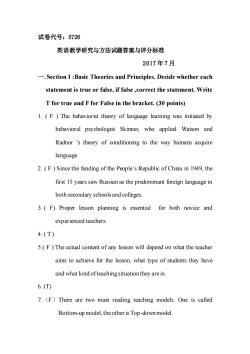
试卷代号:5726 英语教学研究与方法试题答案与评分标准 2017年7月 -Section I:Basic Theories and Principles.Decide whether each statement is true or false,if false,correct the statement.Write T for true and F for False in the bracket.(30 points) 1.(F )The behaviorist theory of language learning was initiated by behavioral psychologist Skinner,who applied Watson and Radnor 's theory of conditioning to the way humans acquire language. 2.(F )Since the funding of the People's Republic of China in 1949,the first 15 years saw Russian as the predominant foreign language in both secondary schools and colleges 3.F)Proper lesson planning is essential for both novice and experienced teachers. 4.(T) 5.(F )The actual content of any lesson will depend on what the teacher aims to achieve for the lesson,what type of students they have and what kind ofteaching situation they are in. 6.(T) 7.(F)There are two main reading teaching models.One is called Bottom-up model,the other is Top-down model
试卷代号:5726 英语教学研究与方法试题答案与评分标准 2017 年 7 月 一.Section I :Basic Theories and Principles. Decide whether each statement is true or false, if false ,correct the statement. Write T for true and F for False in the bracket. (30 points) 1. ( F ) The behaviorist theory of language learning was initiated by behavioral psychologist Skinner, who applied Watson and Radnor ’s theory of conditioning to the way humans acquire language. 2. ( F ) Since the funding of the People’s Republic of China in 1949, the first 15 years saw Russian as the predominant foreign language in both secondary schools and colleges. 3. ( F) Proper lesson planning is essential for both novice and experienced teachers. 4. ( T ) 5.( F ) The actual content of any lesson will depend on what the teacher aims to achieve for the lesson, what type of students they have and what kind of teaching situation they are in. 6. (T) 7.(F)There are two main reading teaching models. One is called Bottom-up model, the other is Top-down model
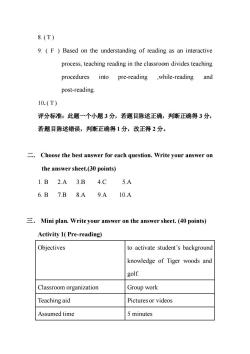
8.(T) 9.F )Based on the understanding of reading as an interactive process,teaching reading in the classroom divides teaching procedures into pre-reading,while-reading and post-reading. 10.(T) 评分标准:此题一个小题3分,若题目陈述正确,判断正确得3分, 若题目陈述错误,判断正确得1分,改正得2分。 Choose the best answer for each question.Write your answer on the answer sheet.(30 points) 1.B2.A3.B 4.C 5.A 6.B7.B8.A 9.A 10.A Mini plan.Write your answer on the answer sheet.(40 points) Activity 1(Pre-reading) Objectives to activate student's background knowledge of Tiger woods and golf. Classroom organization Group work Teaching aid Pictures or videos Assumed time 5 minutes
8. ( T ) 9. ( F ) Based on the understanding of reading as an interactive process, teaching reading in the classroom divides teaching procedures into pre-reading ,while-reading and post-reading. 10. ( T ) 评分标准:此题一个小题 3 分,若题目陈述正确,判断正确得 3 分, 若题目陈述错误,判断正确得 1 分,改正得 2 分。 二. Choose the best answer for each question. Write your answer on the answer sheet.(30 points) 1. B 2.A 3.B 4.C 5.A 6. B 7.B 8.A 9.A 10.A 三. Mini plan. Write your answer on the answer sheet. (40 points) Activity 1( Pre-reading) Objectives to activate student’s background knowledge of Tiger woods and golf. Classroom organization Group work Teaching aid Pictures or videos Assumed time 5 minutes
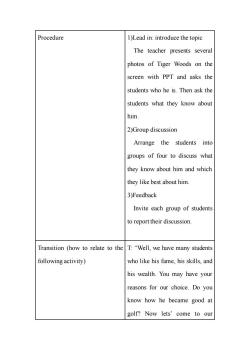
Procedure 1)Lead in:introduce the topic The teacher presents several photos of Tiger Woods on the screen with PPT and asks the students who he is.Then ask the students what they know about him. 2)Group discussion Arrange the students into groups of four to discuss what they know about him and which they like best about him. 3)Feedback Invite each group of students to report their discussion. Transition (how to relate to the T:"Well,we have many students following activity) who like his fame,his skills,and his wealth.You may have your reasons for our choice.Do you know how he became good at golf?Now lets'come to our
Procedure 1)Lead in: introduce the topic The teacher presents several photos of Tiger Woods on the screen with PPT and asks the students who he is. Then ask the students what they know about him. 2)Group discussion Arrange the students into groups of four to discuss what they know about him and which they like best about him. 3)Feedback Invite each group of students to report their discussion. Transition (how to relate to the following activity) T: “Well, we have many students who like his fame, his skills, and his wealth. You may have your reasons for our choice. Do you know how he became good at golf? Now lets’ come to our
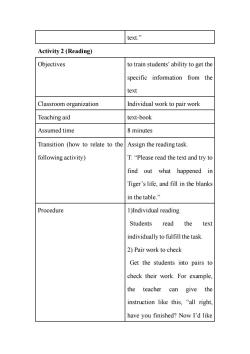
text.” Activity 2 (Reading) Objectives to train students'ability to get the specific information from the text Classroom organization Individual work to pair work Teaching aid text-book Assumed time 8 minutes Transition (how to relate to the Assign the reading task. following activity) T:"Please read the text and try to find out what happened in Tiger's life,and fill in the blanks in the table.” Procedure 1)Individual reading Students read the text individually to fulfill the task. 2)Pair work to check Get the students into pairs to check their work.For example, the teacher can give the instruction like this,"all right, have you finished?Now I'd like
text.” Activity 2 (Reading) Objectives to train students’ ability to get the specific information from the text Classroom organization Individual work to pair work Teaching aid text-book Assumed time 8 minutes Transition (how to relate to the following activity) Assign the reading task. T: “Please read the text and try to find out what happened in Tiger’s life, and fill in the blanks in the table.” Procedure 1)Individual reading Students read the text individually to fulfill the task. 2) Pair work to check Get the students into pairs to check their work. For example, the teacher can give the instruction like this, “all right, have you finished? Now I’d like
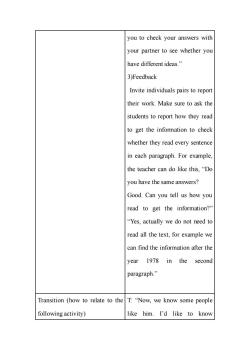
you to check your answers with your partner to see whether you have different ideas." 3)Feedback Invite individuals pairs to report their work.Make sure to ask the students to report how they read to get the information to check whether they read every sentence in each paragraph.For example, the teacher can do like this,"Do you have the same answers? Good.Can you tell us how you read to get the information?" "Yes,actually we do not need to read all the text,for example we can find the information after the year 1978 in the s second paragraph.” Transition (how to relate to the T:"Now,we know some people following activity) like him.I'd like to know
you to check your answers with your partner to see whether you have different ideas.” 3)Feedback Invite individuals pairs to report their work. Make sure to ask the students to report how they read to get the information to check whether they read every sentence in each paragraph. For example, the teacher can do like this, “Do you have the same answers? Good. Can you tell us how you read to get the information?” “Yes, actually we do not need to read all the text, for example we can find the information after the year 1978 in the second paragraph.” Transition (how to relate to the following activity) T: “Now, we know some people like him. I’d like to know
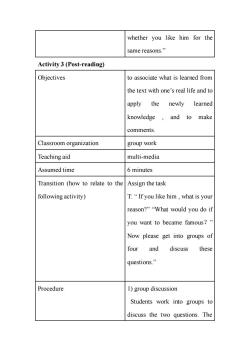
whether you like him for the same reasons." Activity 3(Post-reading) Objectives to associate what is learned from the text with one's real life and to apply the newly learned knowledge,and to make comments. Classroom organization group work Teaching aid multi-media Assumed time 6 minutes Transition (how to relate to the Assign the task following activity) T:If you like him,what is your reason?”“What would you do if you want to became famous? Now please get into groups of four and discuss these questions." Procedure 1)group discussion Students work into groups to discuss the two questions.The
whether you like him for the same reasons.” Activity 3 (Post-reading) Objectives to associate what is learned from the text with one’s real life and to apply the newly learned knowledge , and to make comments. Classroom organization group work Teaching aid multi-media Assumed time 6 minutes Transition (how to relate to the following activity) Assign the task T: “ If you like him , what is your reason?” “What would you do if you want to became famous?” Now please get into groups of four and discuss these questions.” Procedure 1) group discussion Students work into groups to discuss the two questions. The
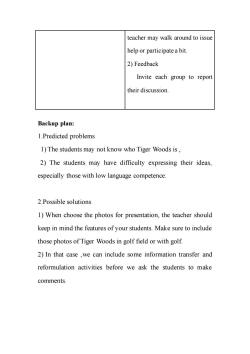
teacher may walk around to issue help or participate a bit 2)Feedback Invite each group to report their discussion. Backup plan: 1.Predicted problems 1)The students may not know who Tiger Woods is, 2)The students may have difficulty expressing their ideas, especially those with low language competence. 2.Possible solutions 1)When choose the photos for presentation,the teacher should keep in mind the features of your students.Make sure to include those photos of Tiger Woods in golf field or with golf. 2)In that case,we can include some information transfer and reformulation activities before we ask the students to make comments
teacher may walk around to issue help or participate a bit. 2) Feedback Invite each group to report their discussion. Backup plan: 1.Predicted problems 1) The students may not know who Tiger Woods is , 2) The students may have difficulty expressing their ideas, especially those with low language competence. 2.Possible solutions 1) When choose the photos for presentation, the teacher should keep in mind the features of your students. Make sure to include those photos of Tiger Woods in golf field or with golf. 2) In that case ,we can include some information transfer and reformulation activities before we ask the students to make comments

评分标准:此题属于教案设计题,可根据教案设计的完整性,科学性, 合理性给分。(答案仅供参考)
评分标准:此题属于教案设计题,可根据教案设计的完整性,科学性, 合理性给分。(答案仅供参考)
按次数下载不扣除下载券;
注册用户24小时内重复下载只扣除一次;
顺序:VIP每日次数-->可用次数-->下载券;
- 山西开放大学:《英语教学研究方法》期末测试(试题).doc
- 国家开放大学:2014年秋季学期“开放专科”汉语言文学专业英语Ⅰ(2)期末试题(1月).pdf
- 国家开放大学:2013—2014学年第一学期“开放专科”广告(设计与制作)专业英语Ⅰ(2)期末试题(1月).pdf
- 国家开放大学:2016年春季学期“开放专科”应用化工技术专业英语Ⅰ(1)期末试题(7月).pdf
- 国家开放大学:2014年春季学期“开放专科”物业管理专业英语Ⅰ(2)期末试题(7月).pdf
- 唐山广播电视大学:《实用英语语音精讲》课程教学资源(试卷习题)模拟试题二及参考答案.docx
- 唐山广播电视大学:《实用英语语音精讲》课程教学资源(试卷习题)模拟试题一及参考答案.docx
- 西安开放大学:《管理英语》课程教学资源(试卷习题)样题及解析.docx
- 广州开放大学:形考试题四(答案).docx
- 广州开放大学:形考试题四(试题).docx
- 广州开放大学:形考试题二(答案).docx
- 广州开放大学:形考试题二(试题).docx
- 广州开放大学:形考试题三(答案).docx
- 广州开放大学:形考试题三(试题).docx
- 广州开放大学:形考试题一(答案).docx
- 广州开放大学:形考试题一(试题).docx
- 上海中医药大学:课程教学大纲汇编合集(外语和计算机类)汇编.doc
- 上海中医药大学:课程教学大纲汇编合集(外语和计算机类)目录.doc
- 上海中医药大学:课程教学大纲汇编合集——教学大纲(外语教学中心).pdf
- 宁波诺丁汉大学:《大学英语》课程教学资源(课件讲稿)CET4/CET6 四六级.pdf
- 国家开放大学:2013—2014学年第一学期“开放专科”信用管理专业英语Ⅰ(1)期末试题(1月).pdf
- 国家开放大学:2014年春季学期“开放专科”信用管理专业英语Ⅰ(1)期末试题(7月).pdf
- 国家开放大学:2014年秋季学期“开放专科”信用管理专业英语Ⅰ(1)期末试题(1月).pdf
- 国家开放大学:2015年春季学期“开放专科”信用管理专业英语Ⅰ(1)期末试题(7月).pdf
- 国家开放大学:2015年秋季学期“开放专科”信用管理专业英语Ⅰ(1)期末试题(1月).pdf
- 国家开放大学:2016年秋季学期“开放专科”信用管理专业英语Ⅰ(1)期末试题(1月).pdf
- 国家开放大学:2016年秋季学期“开放专科”文秘专业英语Ⅰ(2)期末试题(1月).pdf
- 国家开放大学:2009—2010学年第一学期“开放本科”学前教育专业英语Ⅱ(1)期末试题(1月).pdf
- 国家开放大学:2009—2010学年第二学期“开放本科”学前教育专业英语Ⅱ(1)期末试题(7月).pdf
- 国家开放大学:2009—2010学年第二学期“开放本科”学前教育专业英语Ⅱ(2)期末试题(7月).pdf
- 国家开放大学:2010—2011学年第一学期“开放本科”学前教育专业英语Ⅱ(1)期末试题(1月).pdf
- 国家开放大学:2010—2011学年第一学期“开放本科”学前教育专业英语Ⅱ(2)期末试题(1月).pdf
- 国家开放大学:2011—2012学年第一学期“开放本科”学前教育专业英语Ⅱ(1)期末试题(1月).pdf
- 国家开放大学:2011—2012学年第一学期“开放本科”学前教育专业英语Ⅱ(2)期末试题(1月).pdf
- 国家开放大学:2011—2012学年第二学期“开放本科”学前教育专业英语Ⅱ(1)期末试题(7月).pdf
- 国家开放大学:2011—2012学年第二学期“开放本科”学前教育专业英语Ⅱ(2)期末试题(7月).pdf
- 国家开放大学:2012—2013学年第一学期“开放本科”学前教育专业英语Ⅱ(1)期末试题(1月).pdf
- 国家开放大学:2012—2013学年第一学期“开放本科”学前教育专业英语Ⅱ(2)期末试题(1月).pdf
- 国家开放大学:2006—2007学年第一学期“开放专科”会计学专业英语Ⅰ(1)期末试题(1月).pdf
- 国家开放大学:2006—2007学年第一学期“开放专科”会计学专业英语Ⅰ(2)期末试题(1月).pdf
